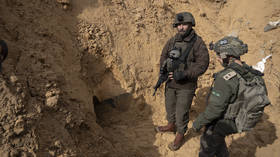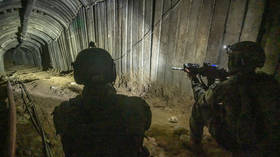Israel confirms flooding of Hamas tunnels

The Israel Defense Forces (IDF) confirmed on Tuesday that it has been flooding Hamas’ underground tunnel network with seawater, a controversial tactic that it first trialed late last year.
In a statement shared with Israeli media, the IDF said that it had developed and was using “several tools for injecting high-flow water into Hamas tunnels in the Gaza Strip.” Not all of the roughly 350-400 miles of tunnels are being targeted, the military said, adding that the operation would cause unacceptable damage in some areas.
Israeli forces installed several high-flow pumps in Gaza late last year and experimented with pumping seawater from the Mediterranean into the underground labyrinth, the Wall Street Journal reported at the time. In a follow-up report on Monday, the American newspaper said that the flooding operation had expanded, with the installation of an additional pump in the city of Khan Younis, located in the south of the enclave.
Until now, Israeli officials have refused to comment on the use of seawater to flood the tunnels. US officials told the Wall Street Journal that “walls and other unexpected barriers and defenses slowed or stopped the water flow” in some places, and that “the overall effort wasn’t as effective as Israeli officials had hoped.”
Despite flooding, bombing, and raids by special forces and robots, between 60% and 80% of the subterranean network remains intact, the newspaper reported.
Back in December, US officials warned their Israeli counterparts that the use of seawater could contaminate Gaza’s limited freshwater resources. Prior to the conflict with Israel, around 90% of the enclave’s drinking water came from groundwater wells, according to the Palestinian Water Authority.
Relatives of the roughly 132 hostages still held by Hamas also fear that flooding the tunnels will endanger their loved ones. In meetings with Israeli Prime Minister Benjamin Netanyahu in December, freed hostages complained that the flooding would be a death sentence for those left behind, according to audio recordings published by Hebrew news site Ynet.
The IDF said that its troops are carrying out “professional and comprehensive” checks to ensure that the operation is not contaminating groundwater sources. However, the military did not mention whether the likelihood of harming hostages was being considered when deciding which tunnels to flood.
Israeli tanks and troops have been on the ground in Gaza since late October. However, while the Palestinian death toll now stands at nearly 27,000, US officials believe that the IDF has killed just a fifth of Hamas’ fighters after almost four months of fighting. The IDF announced the deaths of three Israeli soldiers on Wednesday, bringing to 224 the number killed in Gaza since October.













